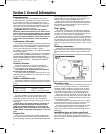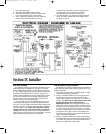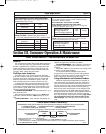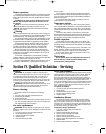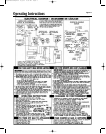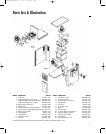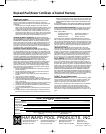
Section III. Consumer Operation & Maintenance
4
General:
Do not operate the heater without water flowing through it.
Do not use the heater if any part has been under water.
Contact a qualified service technician to inspect the entire
heater and replace any part of the control system or gas
valve that was under water. If heater has been totally sub-
merged in water, replace the entire heater.
Pool/Spa water chemistry:
See also Figure 5.
The mineral content of swimming
pool water increases daily due to addition of pool sanitizing
chemicals and natural evaporation. Excess minerals will
deposit on pool walls, in the filtration system, and in the
heat exchanger tubes if the mineral content is too high.
Changing spa water regularly and maintaining correct
chemical balance in pool/spa will keep the pool/spa safe
and sanitary and will protect heater and its warranty cover
-
age. Purchase a good “DPD” water test kit and check the
following chemical levels frequently:
CHLORINE OR BROMINE – Recommended level 1 to 4
ppm. Test before use.
pH – Recommended ideal level 7.4 to 7.6. HIGH read-
ings reduce sanitizer efficiency.
LOW readings are corro-
sive.
TOTAL ALKALINITY – 80 to 120 ppm. Test weekly dur-
ing regular use.
LOW readings are corrosive and cause
rapid pH changes when chemicals are added.
CALCIUM HARDNESS – 200 to 400 ppm. Test whenev-
er pool/spa is filled.
LOW levels of hardness can be very
corrosive.
Remember, addition of any chemicals can change levels
of chlorine, pH, and total alkalinity.
It is recommended that residential spa water be
changed every 2 to 3 months to prevent water problems.
Public spas may need to have the water changed every
week, or even daily, depending on bather load.
Using chlorinators and chemical feeders:
Follow the instructions provided with any automatic or
manual chlorinator and chemical feeder
. If a chlorinator is
used, it must be installed down stream from the heater In
the pool return line. Install a check valve between the heater
outlet and chlorinator to prevent chlorine from siphoning
back into the heater
.
All chemicals must be introduced and
diluted into the pool or spa water before being circulated
through the heater. Do not place chlorine tablets or bromine
sticks directly into the skimmer. High chemical concentra-
tions may result when the pump is not running.
High chemi-
cal concentrations cause very rapid corrosion of the
heat exchanger
. Such damage is not covered under war-
ranty
.
Distance from Tank Iron Tubing
(propane) Pipe
0 to 25feet 3/8” 5/8”
25 to 100 feet 1/2” 3/4”
100 to 200 feet 3/4” 7/8”
Follow local (as codes for proper gas line material selection (copper, iron or plastic etc.)
LOW PRESSURE PROPANE GAS PIPE SIZING “SECOND
STAGE” (Based upon gas pressure of 11 inches W.C. inlet
pressure at a pressure drop of 0.5 inch W.C.)
Gas pipe size:
Figure 4
LOW PRESSURE NATURAL GAS PIPE SIZING:
(Based upon gas pressure of 0.5 psig or less and a
pressure drop of 0.5” W.C.)
LOW PRESSURE PROPANE GAS PIPE SIZING
“SINGLE STAGE”: (Based upon gas pressure of
11” W.C. inlet pressure and a 0.5” W.C. pressure drop)
Distance from Meter Iron
(Natural Gas) Pipe
0 to25 feet 1/2”
25 to 100 feet 3/4”
100 to 200 feet 1”
It is VERY IMPORTANT when installing a propane heater on a
two (2) stage regulation system, to follow the gas line sizing
chart below—without exception.
HIGH PRESSURE “TWO STAGE” SYSTEMS:
HIGH PRESSURE PROPANE GAS PIPE SIZING
“FIRST STAGE”: (Based upon gas pressure of 10 psig inlet
pressure at a pressure drop of 1 psi.)
Dis
tance from outlet of Iron
1st stage regulator to Pipe Tubing
inlet of 2nd stage regulator
0 to 200 feet 1/2” 1/2”
Distance from outlet of Iron
2nd stage regulator to Pipe Tubing
inlet of gas valve
0 to 10 feet 1/2” 1/2”
FOR YOUR SAFETY – READ BEFORE OPERATING
Facts about water chemistry:
FACTORS which affect pool/spa water and, more importantly, the efficiency and operation of the pool/spa heater.
1. PROPER FlLTRATION 2. PROPER CIRCULATION 3. DISINFECTION AND OXIDATION
4. pH CONTROL AND TOTAL ALKALINITY 5. ALGAE CONTROL
What Is pH? It is the measure of the acidity or alkalinity of water. As shown on this chart, it is a critical measurement.
CORROSION
ZONE
SCALING
ZONE
0 1 2 3 4 5 6 7 8 9 10 11 12 13 14
NEUTRAL
7.4 – 7.6
IDEAL
ACID ALKALINE
Hayward recommends using a four way test kit to obtain…
1. MIN./MAX. pH (7.2 - 7.8) 2. CHLORINE RESIDUAL (1.0 - 3.0 PPM), BROMINE (2.0 - 4.0 ppm)
3. TOTAL ALKALINITY (80 - 100 PPM) for calcium, lithium and sodium hypochlorite, or (100 - 120 PPM) for sodium dichlor, trichlor, and bromine.
4. CALCIUM HARDNESS (200 - 400 PPM)
Figure 5
HEAT EXCHANGERS
DESTROYED
HEAT EXCHANGERS
DESTROYED
Hayward0205English 8/3/05 9:38 AM Page 4




